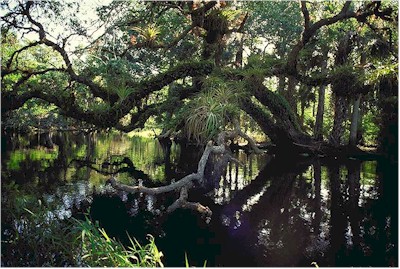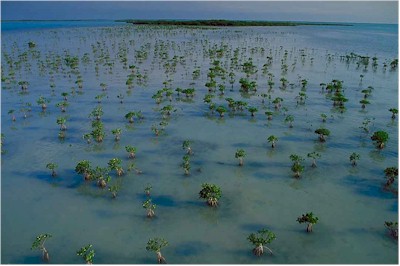Eco-Pros
Environmental Education on the Web
|
|
Wetlands recovery programs are underway in many countries.
|
These
pictures show drained farmland
(on left) before
- and
after the drained wetlands were
restored (on right). Wetlands on private lands such as this are very
important as they provide habitat for nesting waterfowl. Habitat conservation programs that
involve farmers and other large landowners are key to the continued
survival of many species. |
|
|
Many great swamplands have disappeared due to human alteration. Nature Conservancies, Audubon and many other conservation organizations and local groups of citizens have raised funds to purchase wetlands in jeopardy in order to preserve and protect them for the future. Some of the remaining great swamp ecosystems of the U.S. are listed below. They are providing vital functions such as food sources, habitat, water preserves, water filtering, flood control, spawning and fishing grounds, prevention of soil erosion, and preservation of our biological diversity. |
|
Alakai- Kauai, Hawaii Atchafalaya - Louisiana Big Cypress and Corkscrew Sanctuary - Florida Big Thicket - Texas Congaree - South Carolina Everglades - Florida Four Holes Swamp - South Carolina Great Cypress Swamp of Delaware - Delaware Great Dismal Swamp - Virginia and North Carolina Great Swamp of New Jersey - New Jersey |
Great Swamp of Rhode Island - Rhode Island Green Swamp - Florida Honey Island Swamp - Louisiana and Mississippi LaRue Swamp - Illinois Mingo Swamp - Missouri Mountain Swamps of the East - From the Smoky Mts. northward to Canada Okefenokee - Georgia Quakertown Swamp - Pennsylvania Swamp Lakes - Texas and Louisiana Woods Bay - Delaware |
|
Most likely there will never again be the great concentrations of wildlife that once existed prior to human alteration of the natural systems. Even though we now realize the great value of wetlands, there is still great pressure from land promoters, agricultural interests, and oil and timber industries. Look around you - there are swamps, bogs, marshes, sloughs and wetlands located in virtually every state in the United States. Even small ponds are a haven of life for many organisms and animals dependent upon them for survival. There are uncharted wetlands too numerous to count of all sizes and varieties, and they all play an integral role in nature's processes and cycles. Fresh water is necessary for life and we must protect this natural resource for our future survival. |
|
THE EVERGLADES
- AN
ECOSYSTEM IN PERIL
Everglades Restoration Plan - the largest restoration plan on Earth!
The Everglades
- Yesterday and Today In order to try and undo the detrimental effects humans have had on the Everglades, and restore the wetlands as much as possible, we need to understand the workings of the original system and incorporate the science and technology of today into a comprehensive plan for the future. The South Florida
Water Management District, working with other state and federal
agencies, has developed programs that focus on "sound management
based on strong science and data." Information and data is
provided on their website, including: Watershed Management,
Hydrology, Nutrients, Vegetation, Wildlife, and Restoration -
pertaining to the specifics of the Everglades, Florida Bay and the
Entire Ecosystem. Click into Long-Term Plan to learn about the
Everglades of Tomorrow.
The Living
Everglades - One of Earth's great natural ecosystems As more and more people moved to Florida, the needs of humans took precedence over the needs of wildlife and the natural environment. As human development increased, the wetlands decreased, and the magnificent natural process began losing its ability to provide life support services to the once-massive numbers of wildlife; species that not only inhabit the U.S., but migrate south and north from pole to pole. The Living
Everglades website is designed to provide citizens, scientists,
teachers, and students access to a vast amount of information and
data about the Florida Everglades. Maps, Topography, Info and
links to historical information, Geology, Habitats, Wildlife, Water
Resources, Weather, Links, FAQs, Search function, and a page of
links to glossaries. Take a virtual tour, query data.
Educational resources are provided for teachers and students, with
curriculum, lesson plans, fun activities, The Living Everglades
for K-12, and The Everglades - An American Treasure. What we can do to help the Everglades - Information is provided on this site for residents of Florida, and for the many people who visit and travel to Florida, regarding protecting and conserving precious water resources. Learn what activities to avoid that may cause environmental contamination. There are things we do that may seem harmless, but they may set in motion other actions that cause pollutants to be carried to water resources. These helpful tips are good to practice no matter where we live or visit. Water is a shared resource - and we all should share in protecting it. Marjory Stoneman
Douglas - Defender of the Everglades
The Everglades
Ecosystem - Everglades National Park
The Journey to Restore
America's Everglades Everglades Restoration - Audubon of Florida
Florida Everglades Photo Gallery -
Vermont Institute of Natural Science (VINS) See pictures of
Florida's endangered Manatee and Florida Panther on our |
|
TURNING THE TIDE ON EROSION IN GALVESTON BAY Wetlands and marshes were disappearing, and shorebirds and waterbirds were moving away. Concerned local residents went for help. The good news is the U.S. Fish and Wildlife Service awarded two wetland conservation grants totaling over a million dollars to help turn the tide on erosion in West Galveston Bay. The restoration and protection project will take measures to restore wetlands and marshes and build breakwaters, to protect estuarine intertidal marshes from erosion and conserve shoreline, and to protect rookeries and endangered species habitat. |
|
RIVER CORRIDOR
AND WETLAND RESTORATION
RESTORE
AMERICA'S ESTUARIES
NATIONAL
ESTUARINE RESEARCH RESERVE SYSTEM PHOTOS
NOAA
RESTORATION CENTER (NOAA Photo Library) SEARCH ENN
WETLANDS
CONSERVATION GRANTS: NOTE: Changing wetlands without the proper authorization and permit may be considered unlawful and punishable under the rules of the Clean Water Act. See more informational links on our Wetlands Resources page. |
I think I'm in
the wrong place!
I didn't see the word oasis listed as a wetland.
I need to find one. I store water in my humps, but it's time for a refill.
Click on me please,
so I can go look up some resources to find an oasis.
Mouse over
images on the website to see messages - if you see a hand, click on it.






